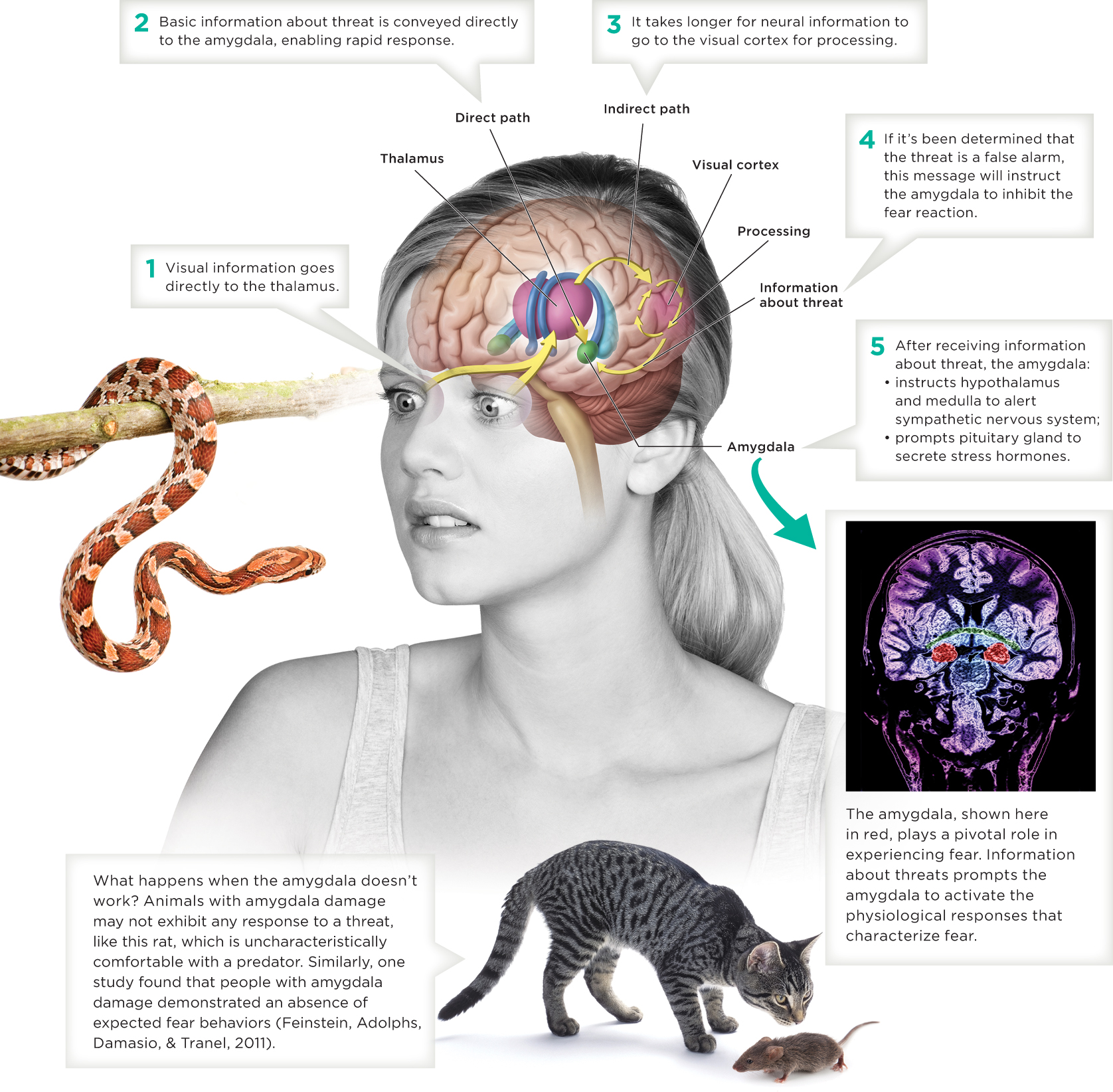9.6 Types of Emotions
Imagine the whirlwind of emotions you would feel if you witnessed a loved one being attacked by a shark. Fear is probably the most obvious, but there are others, including anger toward the shark, disgust at the sight of blood, anxiety about the outcome, gratitude toward those who came to the rescue, and guilt (It should have been me).
Basic Emotions
Are such feelings common to all people? Some researchers have proposed that there is a set of “biologically given” emotions, which includes anger, fear, disgust, sadness, and happiness (Coan, 2010). These types of emotions are considered basic because people all over the world experience and express them in similar ways; they appear to be innate and have an underlying neural basis (Izard, 1992). The fact that children born deaf and blind have the same types of expressions of emotion (happiness, anger, and so on) suggests the universal nature of their displays (Hess & Thibault, 2009).
It is also noteworthy that unpleasant emotions (fear, anger, disgust, and sadness) have survived throughout our evolutionary history, and are more prevalent than positive emotions such as happiness, surprise, or interest (Ekman, 1992; Forgas, 2008; Izard, 2007). This suggests that negative emotions have “adaptive value”; in other words, they may be useful in dangerous situations, for example, those that demand a fight-or-flight response (Forgas, 2008).
This isn’t always the case, of course. Sometimes feelings of fear, anger, disgust, and sadness can be provoked by scenarios that involve no danger whatsoever—like watching a frightening movie.
Fascinating Fear
In the summer of 1975, a film called Jaws hit the box office, inspiring fear in people across America. A horror movie based on Peter Benchley’s popular novel, Jaws told the story of a monstrous great white shark that terrorized beachgoers in a resort community. The movie turned out to be an absolute blockbuster, as people across the country flocked to theaters, apparently fascinated by the horror of it all (BBC, 2001, November 16). Today’s movie buffs are equally intrigued by frightening subjects, whether vampires, supernatural forces, or serial killers. Fear has also captivated psychologists; it remains one of the most heavily researched human emotions.
The Biology of Fear
LO 14 Describe the role the amygdala plays in the experience of fear.
Have you ever wondered what takes place in your brain when you feel afraid? Researchers certainly have. With the help of brain-scanning technologies, they have zeroed in on an almond-shaped structure in the limbic system (Cheng, Knight, Smith, & Helmstetter, 2006; Pape & Pare, 2010). This structure, known as the amygdala, is central to our experience of fear (Davis & Whalen, 2001; Hariri, Tessitore, Mattay, Fera, & Weinberger, 2002). If a person views threatening images, or even looks at an image of a frightened face, the amygdala is activated (Chiao et al., 2008; Laeng et al., 2010).
Pathways To Fear

What exactly does the amygdala do? When confronted with a fear-provoking situation, the amygdala enables an ultrafast and unconscious response. According to LeDoux (1996, 2000, 2012), sensory information (sights, sounds) entering the thalamus can either go to the cortex for processing, or head straight for the amygdala without stopping at the cortex. The direct path that goes from the thalamus to the amygdala conveys raw information about the threat, enabling your brain and body to respond to danger without your awareness. Like a panic button, the amygdala issues an alert, summoning other parts of the brain that play a role in the experience of fear (for example, the hypothalamus and medulla), which then alert the sympathetic nervous system. A pathway also goes to the pituitary gland, resulting in the secretion of stress hormones (LeDoux, 2012).
The snake in the bed example from earlier in the chapter provides a clear example of an immediate fear response. Visual information about the snake goes directly to the thalamus, and from there to the amygdala, which triggers an alarm reaction. Your heart rate increases and breathing becomes rapid, preparing you to flee the slithery, slimy reptile. Meanwhile, information that was sent to the sensory processing centers of the visual cortex results in a visual representation of the snake materializing. You quickly realize that you are looking at a rubber snake, and your cortex sends a message to the amygdala: “False alarm. The snake in the bed is a rubber toy.” The key thing to note is that it takes longer for neural information to go from the thalamus to the cortex than from the thalamus to the amygdala. This explains why one generally needs a moment to calm down: The physiological reaction starts before the false alarm message from the cortex reaches the amygdala (Infographic 9.4).
Evolution and Fear
LeDoux (2012) suggested an evolutionary advantage to these two systems. The direct route (thalamus to amygdala, causing an emotional reaction) has resulted from the evolutionary advantage of being able to react quickly to threats for which we are biologically prepared (snakes, spiders, aggressive faces). The other pathway allows us to evaluate more complex threats (such as nuclear weapons, job layoffs) with our cortex, overriding the fast-response pathway when necessary.
The amygdala also plays an important role in the creation of “emotional memories,” which are fairly robust and detailed (Johnson, LeDoux, & Doyère, 2009; LeDoux, 2002). This is useful because we are more likely to survive if we remember threats in our environments. For some people, however, emotional memories cause troublesome fear and anxiety (Chapter 12).
Autonomic Nervous System and Fear
Earlier in the chapter, we discussed the fight-or-flight response. In a stressful situation, the sympathetic nervous system, which is a part of the autonomic nervous system (ANS), automatically and quickly activates a variety of physiological responses. Blood pressure increases, goose bumps appear, hair stands on end, pupils dilate, digestion stops, blood sugar increases, and so on. The same response can also occur with some other emotions such as love and joy (Levenson, 1992). But separating the physiological profiles of emotions can get tricky, as they often overlap. For example, fear, anger, and sadness are all accompanied by an increased heart rate (Ekman, 2003; Rhudy & Meagher, 2000). Anger is associated with heightened skin temperature and a greater increase in heart rate than fear. Meanwhile, fear promotes increased blood flow to the legs and decreased skin temperature in the hands (Ekman, Levenson, & Friesen, 1983).
Research suggests that the physiological responses resulting from activation of the sympathetic nervous system are universal, and biological response patterns accompanying basic emotions are innate. Irrespective of gender or age, these patterns are the same, although these responses in older adults tend to be less extreme (Levenson, Carstensen, Friesen, & Ekman, 1991).
What happens to these automatic responses when the amygdala is not working? Animal studies suggest that damage to the amygdala impairs the fear response (Bliss-Moreau, Bauman, & Amaral, 2011; Phillips & LeDoux, 1992). Similarly, people with amygdala damage exhibit weaker than normal responses to stimuli that inspire fear or disgust (Buchanan, Tranel, & Adolphs, 2004). They also have difficulty perceiving emotion and comprehending nonverbal behavior associated with emotion (Adolphs, 2008).
INFOGRAPHIC 9.4: The Anatomy of Fear
You instantly recoil when you spot a snake—then sigh with relief just a moment later when it registers that the snake is a rubber toy. Have you ever wondered why you react with fear when a “threat” turns out to be nothing? Why does it take longer for you to process a threat than react to it? Sensory information (sight, sound) entering the brain travels to the thalamus and is then routed to the cortex for processing. Sensory information can also go directly to the amygdala. In the case of a threat, the amygdala alerts other areas of the brain and the endocrine system instantly without waiting for a conscious command. This enables a response to fear before you are even fully aware of what you are reacting to.

Happiness
In the very first chapter of this book, we introduced the field of study known as positive psychology, “the study of positive emotions, positive character traits, and enabling institutions” (Seligman & Steen, 2005, p. 410). Rather than focusing on mental illness and abnormal behavior, positive psychology emphasizes human strengths and virtues. The goal is well-being and fulfillment, and that means “satisfaction” with the past, “hope and optimism” for the future, and “flow and happiness” at the current time (Seligman & Csikszentmihalyi, 2000). Let’s take a moment to explore that flow and happiness of the moment.
LO 15 Summarize evidence pointing to the biological basis of happiness.

The Biology of Happiness
To what degree do we inherit happiness? Happiness has heritability estimates between 35% and 50%, and as high as 80% in longitudinal studies (Nes, Czajkowski, & Tambs, 2010). In other words, we can explain a high proportion of the variation in happiness, life satisfaction, and well-being by considering genetic make-up, as opposed to environmental factors.
Research suggests that the biological basis of happiness may include a “set point,” similar to the set point for hunger (Bartels et al., 2010; Lyubomirsky et al., 2005). Happiness tends to fluctuate around a fixed level (this point is the degree of happiness we experience when we are not trying to be happier). As we strive for personal happiness, it is important to recognize the strength of this set point, which is influenced by genes and temperament. But do not lose hope; researchers also suggest it is possible to increase happiness over time (Lyubomirsky et al., 2005).
CONNECTIONS
In Chapter 8, we described several temperaments exhibited by infants. Around 40% of infants can be classified as easy babies who follow regular schedules, are relatively happy, easy to soothe when upset, and quick to adjust to changes in the environment. The existence of such a temperament lends support to the biological basis of happiness discussed here.
Increasing Happiness
Positive events in our lives generally only seem to bring temporary happiness (Diener, Lucas, & Scollon, 2006; Mancini, Bonanno, & Clark, 2011). Why is this? We tend to become habituated to new feelings of happiness or a new level of happiness rather quickly. If you win the lottery, get a new job, or buy a beautiful house, you will likely experience an increased level of happiness for a while, but then go back to your baseline, or “set point” of happiness (Lyubomirsky et al., 2005). Things that feel new and improved or life-changing quickly become mundane, suggesting that happiness will not be found in new possessions or shopping sprees. The implication is that we need to be careful when pursuing happiness as a goal in life, as we don’t want to emphasize obtaining a specific outcome (like moving to a house near the ocean) or acquiring a desired object (Lyubomorsky et al., 2005). Our focus should not be on becoming happier, but rather on being content with what we have (Lyubomorsky, Dickerhoof, Boehm, & Sheldon, 2011).
In Chapter 5, we presented the concept of habituation, a basic form of learning in which repeated exposure to an event generally results in a reduced response. Here, we see the same effect can occur with events that result in happiness. With repeated exposure, we will habituate to an event that initially elicited happiness.
There are many steps you can take to increase your level of happiness. Engaging in physical exercise, showing kindness, and getting involved in activities that benefit others are all linked to increased positive emotions (Lyubomorsky et al., 2011; Walsh, 2011). The same can be said for recording positive thoughts and feelings of gratefulness in a journal. One group of researchers asked participants to write down in a diary those aspects of their lives for which they were grateful each day. The researchers measured well-being and found that the participants in the diary group were better off than those not counting their blessings. We can change our happiness by changing this aspect of our thinking. The participants who recorded their blessings were also more likely to report they had helped someone else or offered emotional support to another (Emmons & McCullough, 2003). Another way to increase happiness is to identify and actively pursue goals that will have an important effect on your life (Brunstein, 1993). Write down what you are trying to accomplish and take action to make it happen. Knowing what you are actively working toward and being committed to attainable goals are associated with increased feelings of well-being and happiness. There may be a genetic component of happiness, but nature isn’t everything. Life is what you make of it, and happiness is yours to discover.
All of the above activities are within your control, but some variables in the happiness equation are not easily manipulated. If only the morning could last all day long….
from the pages of SCIENTIFIC AMERICAN
Happy in the Morning
Twitter reveals daily emotional rhythms are consistent across cultures.
“Happy hour” is not when you might expect it to be, according to a new analysis of about half a billion Twitter messages from around the globe. On average, people are chipper when they wake up and become grouchy as the day wears on. This pattern holds true on weekends, too, but is delayed by about two hours—a trend confirmed in tweets from the United Arab Emirates, where the workweek is Sunday through Thursday. The data suggest that sleep schedules strongly influence mood cycles. The duo at Cornell University who carried out the research, published last September in Science, say that the rising popularity of online social media is allowing scientists to study human behavior in surprising new ways. Janelle Weaver. Reproduced with permission. Copyright © 2012 Scientific American, a division of Nature America, Inc. All rights reserved.
Gender and Emotions

Urban myth, common sense, stereotypes, and our daily experiences in North America all lead us to believe that men and women experience and express their emotions differently, but is this true? Are women really more “emotional” than men? Do men hide their emotions? Barrett and Bliss-Moreau (2009) set out to answer some of these very questions. In their study, participants were shown pictures of faces expressing emotions such as anger, happiness, and sadness. Each of the faces was paired with a label stating some situational cause for its emotion (for example, a face showing anger was paired with the phrase “insulted by a stranger”). Then the participants were shown the same images without any label, and asked to state whether the individual depicted was “emotional” or “having a bad day.” Female expressions were more likely to be described as emotional, whereas the male faces were more likely to be labeled as having a bad day. Apparently, the participants assumed that the female emotions stemmed from some internal characteristic (being an “overly emotional female”). Meanwhile, the men’s emotions were presumed to be responses to situations or environments (Chapter 15).
The gender differences suggested by the participants’ beliefs in Barrett and Bliss-Moreau’s study are not necessarily accurate, however. Most psychologists studying gender differences suggest that men and women are more similar than different when it comes to experiencing and expressing emotion (Else-Quest, Higgins, Allison, & Morton, 2012). As noted earlier, there are universal facial expressions, and these are similar across gender. But the notion that women are more emotional is a gross over-generalization at best.
Mohamed: Did you do extracurricular activities in high school, and did they help make you feel connected?
That being said, research has uncovered some interesting gender disparities related to emotion. Some evidence suggests that women tend to feel more guilt, shame, and embarrassment than men (Else-Quest et al., 2012). They also seem to be more adept at identifying the emotion behind a particular face (Hall & Matsumoto, 2004). We don’t know if this results from biological or cultural differences (perhaps women start practicing earlier, and this ability becomes more automatic for them). Women who paid closer attention to eyes, in one study, were able to discern emotional expressions more quickly and correctly than men, suggesting that the eyes are especially important for conveying emotions (Hall, Hutton, & Morgan, 2010). With that thought in mind, take a minute and look into the eyes of Mohamed (below). Do you see a look of happiness and tranquility? We certainly do.
Closing Thoughts

Before moving on, let’s briefly outline what we have learned in this chapter. The success story of Mohamed Dirie introduced us to the concept of motivation, a stimulus or force that can direct the way we behave, think, and feel. Early attempts to explain motivation include the instinct theory, which suggests that human behaviors are driven by instinct. But the evidence to support this notion was scanty, and it was eclipsed by other theories, some emphasizing basic physiological drives and others incorporating high-level needs such as self-transcendence. Using the example of Lucy and the shark, we ventured into the complexity of human emotion, examining the theories of its origins, and the many faces and forms it can assume. Although our understanding of emotions remains incomplete, we know that many are universal. So whatever you may be feeling at this moment, you can be certain that someone else has felt the same way. Emotions are what bring humankind together.
show what you know
Question 9.20
1. Researchers have found that when people view images that are threatening, or when they see images of faces of people who are afraid, the ________ becomes active.
amygdala
Question 9.21
2. How would you explain to a fellow student what the following statement means: Happiness has heritability estimates as high as 80%?
Heritability is the degree to which heredity is responsible for a particular characteristic in a population. In this case, the heritability for happiness is as high as 80%, indicating that around 80% of the variation in happiness can be attributed to genes, and 20% to environmental influences. In other words, we can explain a high proportion of the variation in happiness, life satisfaction, and well-being by considering genetic make-up, as opposed to environmental factors.
Question 9.22
3. When confronted by a potential threat, such as a shark, your heart starts pounding, your breathing speeds up, and your pupils dilate. These changes are activated by
- the cognitive appraisal approach.
- the cortex.
- the sympathetic nervous system.
- gender differences.
c. the sympathetic nervous system.